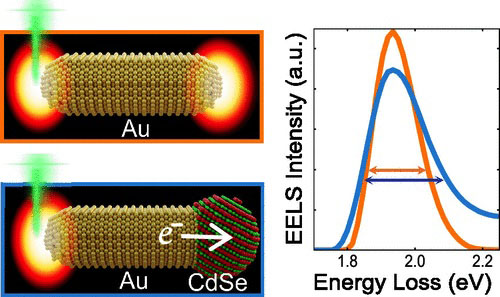| May 12, 2023 |
Boosting solar efficiency with nano matchsticks
(Nanowerk News) Researchers in Australia have demonstrated a highly efficient mechanism for extracting energy from metal nanocrystals, with potential benefits in photovoltaics, photocatalysis and optoelectronics.
|
|
Based at RMIT University and CISRO, the Exciton Science-led team created nanometre-sized ‘matchsticks’ – tiny structures made with gold nanorods and cadmium selenide tips.
|
|
The metal end of the matchstick structure operates like antennas for capturing light, and their interaction with the tip results in the accumulation of electrical charges.
|
|
By creating the optimal structure, the researchers demonstrated the potential to reach charge extraction efficiencies of up to 45%.
|
|
The study is an indication of the promise this approach holds for important energy-harvesting and industrial applications, including solar-powered hydrogen production.
|
|
The results have been published in the journal ACS Nano ("Optimal Geometry for Plasmonic Hot-Carrier Extraction in Metal–Semiconductor Nanocrystals").
|
 |
| Using single-particle electron energy loss spectroscopy, the researchers correlate the geometrical and compositional details of individual nanostructures to their carrier extraction efficiencies. By removing ensemble effects, they are able to show a direct structure–function relationship that permits the rational design of the most efficient metal–semiconductor nanostructures for energy harvesting applications. In particular, by developing a hybrid system comprising Au nanorods with epitaxially grown CdSe tips, it becomes possible to control and enhance charge extraction. (≅ ACS)
|
|
Led by PhD candidate Lesly Melendez and Associate Professor Daniel Gomez of RMIT, the work focused on extracting charge via plasmons, a term for the collective oscillation of electrons in a metal.
|
|
When a photon of light with a certain energy level is absorbed by a material, it promotes the movement of an electron from a metal into a semiconductor, so called ‘hot electron transfer’.
|
|
However, collecting charge from plasmons efficiently (and understanding their behaviour) is difficult, because they ‘relax’ and release their energy so rapidly.
|
|
The team used a research technique called single-particle electron energy loss spectroscopy (EELS) to better understand the relationship between the structure and the function of the metal-semiconductor system.
|
|
EELS is a high-resolution electron microscope based-technique useful for studying nanocrystals because it provides a direct correlation between function and detailed information on particle size, geometry and composition.
|
|
Few previous studies have shown the potential of EELS for evaluating electron and energy transfer between a metal nanoparticle and a semiconductor material.
|
|
By applying it to the gold nanorod structures, the researchers were able to find some of the highest levels of plasmonic hot carrier generation reported to date.
|
|
EELS allowed them to identify which parameters control the efficiency of charge separation, including the quality of the interface between the gold and the cadmium selenide and the size of the metal rod.
|
|
The findings should underpin the best future design approach for these structures, which could feature a sophisticated synthesis mechanism that can create efficient nanostructures at scale.
|

